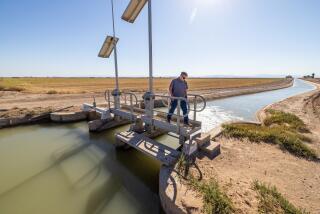California Cities, Farmers Clash Over Insatiable Thirst
- Share via
Earth to Southern California: You can’t go on drinking this way.
The most populous section of the nation’s most populous state is getting notice that its long happy hour--a half-century of free-flowing water from the Colorado River--is almost over.
The Southwest now soaks up, on paper at least, more water than the river carries most years. Told they must stop “borrowing” other states’ water, Californians are eyeing each other’s entitlements.
Farmers in California’s Imperial Valley--who have rights to more Colorado River water than most Western states use--are finding they control a commodity more valuable than their alfalfa or lettuce.
Thanks to full reservoirs, nobody will get thirsty soon. But somebody will surely get upset.
“Right now the stakes are so large, and the game, or winning the war, seems so important to one side or another,” said Timothy H. Quinn, deputy general manager of the giant Southern California Metropolitan Water District.
“There’s just a heck of a lot going on right now in the way of negotiations, decisions,” said Quinn, whose agency carries water to more than 16 million Southern Californians, 220,000 new ones each year.
“The future of the next 25 or 30 years is being determined within the next couple of years.”
California’s classic water conflicts began with the century, when Los Angeles tapped--some say stole--the Owens River, 230 desert miles to the north.
The fights pitted North against South, farms against cities, and later, environmentalists against all. They inspired a classic movie, “Chinatown.” They caused a tragedy: the collapse of St. Francis Dam in 1928 that killed nearly 500.
The drought of the late 1980s and early ‘90s forced the combatants together to salvage the Sacramento River drainage. Heart of the state’s water system, it remains the main source for Southern California.
“That consensus was not possible until we had gone through a very ugly period of conflict,” Quinn said. “Unfortunately, with some of the Colorado questions, we are just entering that stage.”
Stage center is southeastern California, in the man-made oasis of the Imperial Valley, population 140,000. Farmers there have senior rights to more than three times the amount of Colorado water now used by the entire state of Utah. Their harvest is worth $1 billion a year.
If drought dries up all the pools in Beverly Hills, farmers like John Grizzle can still soak their crops. The Imperial Irrigation District controls about 3.5 million of California’s 4.4 million acre-feet of Colorado water.
An acre-foot would fill a wading pool the size of a football field. Experts say it is enough water for two average families a year. It takes six acre-feet to irrigate one of Grizzle’s “average” acres.
“If we let it go, we want to make sure we get a good price for it,” said Grizzle, who has raised hay, cattle and produce for 33 years. “We’re talking about the lifeblood of the valley.”
The Metro district is entitled to 550,000 acre-feet from the river, about a quarter of its needs. Metro has been using up to 1.2 million out of other states’ shares.
Those shares now water new towns and suburbs from Denver to Phoenix. The neighbors want to see California’s water plan, when it gets one.
California must begin bringing demand into balance with supply. And that’s going to be expensive.
“Yes, that’s inevitable,” Quinn said. “The question is how much are you going to have to pay, and when are you going to have to start paying it?”
At least city dwellers won’t have to worry about water bills like Grizzle’s--up to $15,000 a month. Much of his cost is for equipment and delivery. He pays only $13 an acre-foot for water his district gets free.
Metro, a wholesaler with 27 member customers from Los Angeles to San Diego, charges up to $349 an acre-foot. The money maintains nearly 800 miles of canals, pipelines and aqueducts across some of the harshest desert on earth.
The agency is building more. A giant new reservoir near Hemet in central Southern California will hold an emergency earthquake supply for Los Angeles. The way fault lines run, however, San Diego can’t count on the Eastside Reservoir.
San Diego, a Metro member, wants to buy water from the Imperial Valley and use Metro pipe to carry it 100 miles or so west. The latest arguments erupted over that proposition.
Metro’s answer was “wheeling,” or carrying a commodity to a buyer on behalf of an outside seller, as do gas and electricity companies.
Since Metro members must maintain the system, the agency wants a $262 per acre-foot wheeling maximum to cover costs.
“I think Metro has viewed us as their own private water source down here,” Grizzle said. “I think they have to get real and stop playing games and let this deal happen.”
Imperial’s deal with San Diego would bring the farm district nearly $300 million over 10 years. It would start with a 1999 shipment of 20,000 acre-feet at $200 and go up from there, in quantity and price.
Metro wants Imperial to say exactly how much irrigation water it needs a year. The rest would theoretically be available for people, power generation or the river itself.
“When you start doing that kind of different access . . . you’re asking for political warfare,” Quinn said.
The battleground moved this spring to Sacramento, where opposing legislators squared off.
“What we’re working on now, with the rest of California, is to live within the entitlement for California,” said Patricia Brock, spokeswoman for the Imperial district.
The sold water, legally for agriculture rather than cities, must be freed up by conservation measures like recycling, lining or covering canals.
“We like to point out that farming is market driven, and that water has value,” Brock said. “I don’t think people think about the water they eat every day when they eat a plate of food, and what it took to grow that.”
Also at odds with Imperial is the neighboring Coachella Valley Water District, which has subordinate rights.
Once watering just farms, it now supplies golf courses, housing tracts and Indian casinos east of Palm Springs, one of the fastest-growing areas of the country.
“We need to look at the northern [California] water,” Grizzle said. “Some of that water’s going to have to flow down into Southern California.
“A lot of it just goes into the ocean. . . . I know that environment and the fish and all are a concern, but people come first, and people have to eat.”
More to Read
Sign up for Essential California
The most important California stories and recommendations in your inbox every morning.
You may occasionally receive promotional content from the Los Angeles Times.










